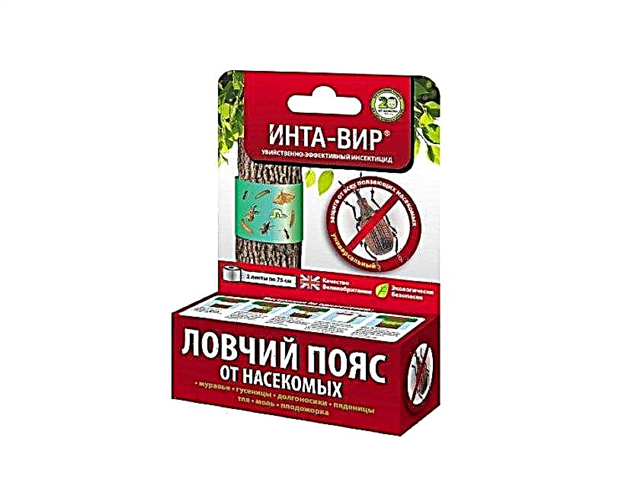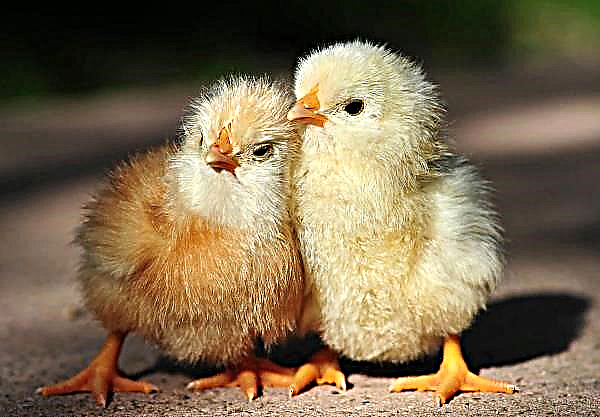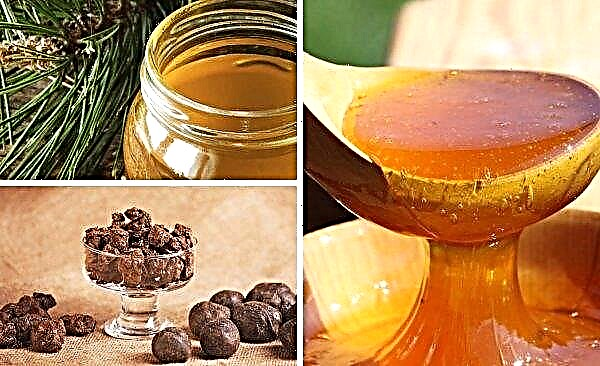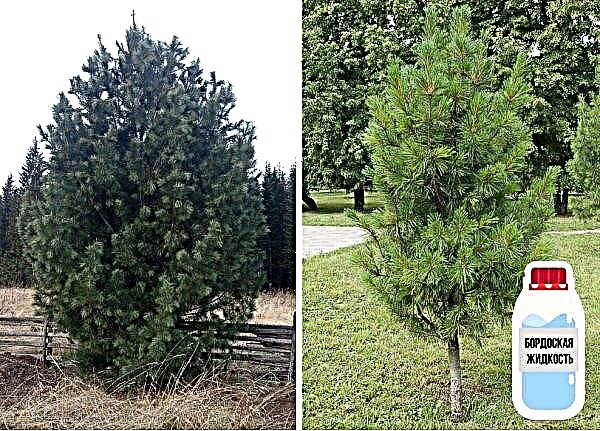Tomatoes grown in a greenhouse are not always protected from parasite damage. In order to preserve the crop and stop their distribution, they must be fought. With effective methods of control and prevention, how to identify the cause of the appearance of caterpillars on tomatoes in a greenhouse, you can get acquainted in this article.
What caterpillars eat tomatoes in a greenhouse
In a greenhouse on tomatoes, two types of caterpillars parasitize - scoops and whiteflies. They differ both in appearance and the damage they cause to plants is also not the same.
Scoops
These caterpillars affect not only tomatoes, but also other vegetable crops. They live mainly in open ground, but can penetrate into the greenhouse. Scoops cause significant damage to beds with tomatoes. If these pests are not controlled, they will multiply, spreading throughout the garden and affecting the rest of the cultivated crops. Even winter is not a hindrance to them, as parasites in the ground overwinter.
Developing, scoops go through three stages:
- larvae;
- caterpillars
- pupae;
- butterflies.
Important! Tomatoes are most harmed by scoops at the caterpillar stage when they eat the fruit. The tomatoes in which they settled are unsuitable for food.
The appearance of the scoop is as follows:
- The eggs of these insects are small, up to 0.5 mm. Their lower part is flat, and the upper one is slightly elongated. Scoops lay eggs on the lower part of the leaves, so it is difficult to find the clutch. Fertility is great: only one butterfly during the season can lay up to 500 eggs. Over the summer, usually a change of at least two generations takes place. The third generation leaves for the winter in the soil. Eggs ripen very quickly - it takes from 2 to 10 days, moreover, the process is faster in heat.
- Caterpillars come in different colors, usually the color is not too bright: there are green, gray, yellow, brown. The body of the caterpillars is bare, with sparse bristles. Three bright stripes pass along the body. It is at the second stage of development that scoops cause the greatest harm to tomatoes. They actively feed on leaves and stems of plants, switch to flowers, after which they are also taken for juicy fruits, gnawing holes in them and settling inside. The caterpillars of the scoop live for about 20 days, after which they move to the next stage.
- Pupa scoops do not harm plants. The insect is inactive at this stage of development. It is sealed for subsequent transformation into a closed pupa. The color is usually dark brown. A butterfly passes through the pupal stage, usually in the upper layer of soil, deepening to 10-15 cm.
- An adult butterfly looks like a moth with a faded brown-gray color; patterns on the wings, the wingspan reaches 2.5-4.5 cm. Adults do not harm crops, since their main food is nectar. However, they lay their eggs en masse, giving life to new generations. The butterfly of an adult scoop can, constantly laying eggs, live from 20 to 40 days.
Scoops - nocturnal insects. In the afternoon, they hide in the topsoil, and when it gets dark they get out and attack the plants.
Whiteflies
These are very tiny white moths that resemble midges. Their size does not exceed 3 mm (and sometimes it happens in the range of 1.2-1.8 mm). The abdomen of the insect is yellowish in color, and small wings are covered with whitish pollen. Adult individuals live on both the outer and inner sides of the leaves. It’s easy to find them by shaking the plant. Alarmed, they fly up in a thick white swarm.
Whiteflies represent the greatest danger at the larval stage. They are inactive, completely crumbly in size, located on the leaves of plants from the bottom. The color is pale, nondescript, half transparent. At first, the larvae are able to move around, so they are also called "tramps." They migrate between the stems and leaves, choosing the most juicy and nutritious place.
Important! In addition to absorbing plant juices and attracting sooty mushrooms, whiteflies are also dangerous because they cause epidemics of bacterial infections, of which they are carriers.
By the time they turn into a butterfly, the larvae are attached to a permanent place and covered with a coating similar to wax. At this time, these pests are no longer afraid of any insecticides or pesticides. Whitefly larvae are similar to aphids - they also suck out juices from the plant. However, the danger of whiteflies is not only that they deprive plants of vitality. In the process of nutrition, these parasites produce a specific fluid - sticky, sugary, sweet. The secret covers the leaves and attracts sooty mushrooms and ants, who are very fond of such substrates.
Fungi, once in the nutritious soil left by whiteflies, multiply and grow. In their habitats, a black coating forms, covering the leaves, which does not let the sun's rays pass to the leaves. This becomes an obstacle to the process of photosynthesis. As you know, photosynthesis is the basis of plant life. When this possibility is limited, garden crops, already weakened by the loss of juice due to larvae, gradually die: the leaves turn yellow and fall, the processes of growth and development stop, the crop becomes very poor. Gradually, the black plaque also passes to the fruits, covering them from the outside, and inside they acquire a white color, become inedible.
As you know, photosynthesis is the basis of plant life. When this possibility is limited, garden crops, already weakened by the loss of juice due to larvae, gradually die: the leaves turn yellow and fall, the processes of growth and development stop, the crop becomes very poor. Gradually, the black plaque also passes to the fruits, covering them from the outside, and inside they acquire a white color, become inedible.
Whiteflies prefer to live in closed, warm and humid spaces. The greenhouse is perfect for them. Open ground is avoided, since there it is dangerous for them to cool, wind and predators feeding on them. But the cold can not stand. If the temperature drops below + 10 ° C, whiteflies die. Butterflies, on the other hand, tolerate frost well and calmly winter in the upper soil layer.
Signs of occurrence
The appearance of caterpillars on tomato bushes significantly affects their well-being, therefore, it is quite easy to notice pests by the following signs:
- leaves dry, curl and fall;
- stems and foliage are damaged, holes appear on them;
- the plants look weakened;
- growth retardation;
- delay in the appearance and ripening of fruits;
- scarcity of fruiting;
- deep black holes in the fruit;
- foliage is covered in black;
- when shaking the bush, a swarm of white "midges" rises into the air;
- clutches of eggs and larvae are found on the back of the leaves.
Did you know? A scoop has natural enemies in nature. Among these insects are a trichogram, a tahina fly and a rider.
Why they appear
The reasons for the appearance of pests on tomatoes are not so many. Butterflies look for favorable places to live in a warm and protected greenhouse where they stay.
Several reasons for the appearance of caterpillars in the greenhouse:
- Lack of preventive measures when arranging a new greenhouse. Eggs scoop and whiteflies winter in the soil. If the greenhouse is equipped on an infected site, then with the onset of heat, pests can be expected to appear on greenhouse plants.
- Penetrate through windows, windows and doorways. Butterflies can simply fly into the greenhouse and stay there, giving life to new generations.
- Infected new plants. Whitefly larvae can take root on newly acquired plants in the store. It can be very difficult to notice them, and sometimes even impossible.

How to process and how to get rid of caterpillars on tomatoes in a greenhouse
All caterpillar control methods are divided into two large groups:
- Chemicals - you need insecticides from the manufacturer;
- Folk remedies, involving the use of natural materials and the collection of pests manually.
Each of the methods has its pros and cons, it can be quite effective if applied correctly and on time, when the tracks are most susceptible to such an effect.
Important! The use of chemicals during the harvest period is strictly prohibited. At this time, it is permissible to use only natural products, since fruits treated with insecticides are toxic and dangerous to humans.
Chemicals
The market offers a wide variety of chemicals that are effective in controlling pests - the scoop and whitefly caterpillars.
The most effective are:
- "Spark" - A manufacturer offering a number of pest drugs. All drugs have a complex effect, are effective against many tens of pests. It is necessary to breed each means according to the instruction. The action lasts up to 2-3 weeks. Fruits can be harvested and eaten only after this period (this is when the crop is considered cleared of the toxic effects of the drug).

- Lepidocide - This drug can be used at any stage of plant development. Processing is carried out repeatedly up to 3 times with an interval of 5-10 days. The solution is prepared at the rate of 35-70 ml of the drug per 10 liters of water. Harvesting is allowed 5 days after the last processing.

- Kinmix - a means of complex effects. It has low phytotoxicity. The effect lasts up to 3 weeks. You can re-process. The solution is prepared from 1 ampoule of the drug, diluted in 10 liters of water. Leaves of plants need to be processed from two sides. Harvest can be 2 weeks after processing.

- Decis - most effective against scoop. Processing should be carried out twice during the growing season. Dilute the insecticide at the rate of 0.5 g of powder per 10 l of water.

- Inta-Vir (analog - Citcor) - well exterminates the whitefly. The effect lasts about two weeks. It is best to use the tool with the maximum accumulation of pests. For tomatoes, 1 tablet of the drug is diluted in 10 liters of water. After two weeks, if necessary, you can re-spray the tomato bushes.

- Confidor - a new tool on the market, a powerful, fast-acting and effective against most pests. Best suited for processing indoor plants. Parasites massively die in less than 5 days after the initial treatment. Economical to use: you need only 1 ml of the drug, diluted in 10 liters of water, to process 100 sq.m. For tomatoes, the consumption rate is 0.3-0.5 l of solution per 1 ha. Processing can be carried out only 1 time (and no later than 20 days before harvesting).

Using the above tools is most effective if the tracks just appeared. Such processing is most often necessary several times, because several generations of pests usually develop in one area. The first time re-treatment is carried out already a week after the primary. In the future, you can hold these events 2-3 more times with an interval of one week.
Did you know? The wax substance that covers whitefly larvae before being transformed into a butterfly is such a reliable protection that it completely protects the larva from any poisons.
Folk methods
If the use of chemical poison is impossible, then use folk natural remedies.
Among them are especially distinguished:
- Infusion of garlic and herbs (wormwood, celandine, tobacco, shag). You need to take 200 g of garlic heads and 400 g of any herb. Heat 10 l of water to + 70 ° C and add garlic and herbs with this water. Let the infusion stand for 24 hours. After this time, the mixture must be filtered and added to a solution of laundry soap - 40 g.
- Wormwood infusion. Take 1 kg of wormwood and 3 liters of water. Boil water and add wormwood. Boil a quarter of an hour. Let cool and treat crops. Processing can be repeated, but after a week.

- Infusion on potato tops. To prepare the infusion, you need to take 1 kg of tops and 10 liters of warm water. Pour the tops with water and let stand for about 4 hours. Then strain and add a bar of soap (40 g).

- Saline solution. Salt must be dissolved in water (the water should be salty enough to taste) and sprayed with plants. You can sprinkle bushes on top of salt. However, saline better covers the entire plant mass.
- Pollination with a mixture of wood ash, tobacco dust and lime. All ingredients must be taken in equal proportions and thoroughly mixed and pollinated affected bushes.
- A solution of soap and kerosene. Take a bar of laundry soap (400 g) and dissolve it in 1 liter of warm water. Pour 800 ml of kerosene into the resulting solution. Add another 9 liters of water to this mixture. Proceed with the treatment of diseased plants immediately after preparation of the solution.
- Cold water. It helps to fight whiteflies especially well. Therefore, it is enough to wash the leaves of tomatoes with very cold water. To prevent plants from experiencing shock, it is better to wash in the predawn hours, when the air temperature is low.
Did you know? Some flowers can protect the garden from many pests, including caterpillars. This, for example, calendula, chamomile, marigolds. They secrete volatile, which repel most parasites.
Useful Tips
In addition to using various means by which tomato bushes are treated during the invasion of caterpillars, mechanical action must also be included in the arsenal of struggle (only in this case the effect will be most effective).
Recommendations are as follows:
- Since both scoops and whiteflies hibernate in the upper soil layer, it is necessary to dig it in the fall after harvesting and in the spring before planting.
- If the infection of the greenhouse was significant, then in the fall it will be necessary to completely remove the entire top layer of the earth (about 15 cm).
- The soil before planting can be calcined with boiling water or disinfected with a solution of potassium permanganate, which not only destroys pests, but also is a fertilizer.
- If caterpillars are found on the leaves, remove them manually further. Turn the leaves over and collect the caterpillars and eggs.
- Take therapeutic measures at the first appearance of pests. Do not allow the growth of caterpillars, as with age they become worse and more susceptible to destruction.
- Throughout the growing season (from planting tomatoes to harvesting), loosen the soil regularly. This will allow you to destroy the eggs of butterflies in time.
- Weed the soil in the greenhouse and destroy the weeds that act as additional food for butterflies and caterpillars. If insects are destroyed on tomatoes, they can remain on the weeds, and from there again spread to garden crops.
- In winter, soil that has been infected with parasites can be poured with cold water. The soil will freeze well, which is why the number of pupae and eggs in it will be significantly reduced.
- Whiteflies fly well on regular fly sticky tapes (especially if they are yellow). Hang these over diseased plants and by the evening you will see how many butterflies fall into the trap.

Preventive measures
Fighting caterpillars is always more difficult than preventing their occurrence.
To protect your greenhouse beds from harmful insects, procedures are necessary for the prevention of:
- Before building a greenhouse, process the topsoil in the area where you plan to build a greenhouse. Loosen, calcine and disinfect.
- Before the beginning of the growing season, provide all the window and doorways of the greenhouse with mosquito nets with very small holes.
- Quarantine new plants that are transplanted into the greenhouse. To do this, keep this plant separate from all the others for several weeks. During this time, whitefly larvae, if they were on leaves or stems, will grow, turn into butterflies and become noticeable.
Caterpillars on tomatoes in a greenhouse harm plants, which negatively affects crop yields. Therefore, pest control should be done well in advance, at the first sign of occurrence or when the first individuals are found. The best protection against caterpillars is prevention.Preventive measures are always easier to implement than treatment.




















